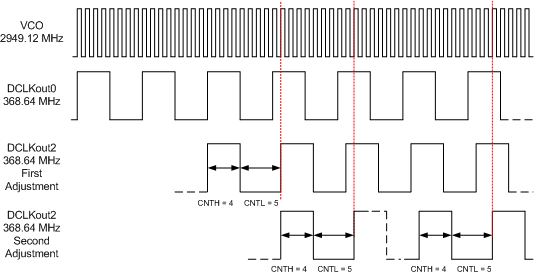SNAS605AS March 2013 – May 2020 LMK04821 , LMK04826 , LMK04828
PRODUCTION DATA.
- 1 Features
- 2 Applications
- 3 Description
- 4 Revision History
- 5 Device Comparison Table
- 6 Pin Configuration and Functions
- 7 Specifications
- 8 Parameter Measurement Information
-
9 Detailed Description
- 9.1
Overview
- 9.1.1 Jitter Cleaning
- 9.1.2 JEDEC JESD204B Support
- 9.1.3 Three PLL1 Redundant Reference Inputs
- 9.1.4 VCXO/Crystal Buffered Output
- 9.1.5 Frequency Holdover
- 9.1.6 PLL2 Integrated Loop Filter Poles
- 9.1.7 Internal VCOs
- 9.1.8 External VCO Mode
- 9.1.9 Clock Distribution
- 9.1.10 Zero-Delay
- 9.1.11 Status Pins
- 9.2 Functional Block Diagram
- 9.3 Feature Description
- 9.4 Device Functional Modes
- 9.5 Programming
- 9.6 Register Maps
- 9.7
Device Register Descriptions
- 9.7.1 System Functions
- 9.7.2
(0x100 - 0x138) Device Clock and SYSREF Clock Output Controls
- 9.7.2.1 CLKoutX_Y_ODL, CLKoutX_Y_IDL, DCLKoutX_DIV
- 9.7.2.2 DCLKoutX_DDLY_CNTH, DCLKoutX_DDLY_CNTL
- 9.7.2.3 DCLKoutX_ADLY, DCLKoutX_ADLY_MUX, DCLKout_MUX
- 9.7.2.4 DCLKoutX_HS, SDCLKoutY_MUX, SDCLKoutY_DDLY, SDCLKoutY_HS
- 9.7.2.5 SDCLKoutY_ADLY_EN, SDCLKoutY_ADLY
- 9.7.2.6 DCLKoutX_DDLY_PD, DCLKoutX_HSg_PD, DCLKout_ADLYg_PD, DCLKout_ADLY_PD, DCLKoutX_Y_PD, SDCLKoutY_DIS_MODE, SDCLKoutY_PD
- 9.7.2.7 SDCLKoutY_POL, SDCLKoutY_FMT, DCLKoutX_POL, DCLKoutX_FMT
- 9.7.3
SYSREF, SYNC, and Device Config
- 9.7.3.1 VCO_MUX, OSCout_MUX, OSCout_FMT
- 9.7.3.2 SYSREF_CLKin0_MUX, SYSREF_MUX
- 9.7.3.3 SYSREF_DIV[12:8], SYSREF_DIV[7:0]
- 9.7.3.4 SYSREF_DDLY[12:8], SYSREF_DDLY[7:0]
- 9.7.3.5 SYSREF_PULSE_CNT
- 9.7.3.6 PLL2_NCLK_MUX, PLL1_NCLK_MUX, FB_MUX, FB_MUX_EN
- 9.7.3.7 PLL1_PD, VCO_LDO_PD, VCO_PD, OSCin_PD, SYSREF_GBL_PD, SYSREF_PD, SYSREF_DDLY_PD, SYSREF_PLSR_PD
- 9.7.3.8 DDLYdSYSREF_EN, DDLYdX_EN
- 9.7.3.9 DDLYd_STEP_CNT
- 9.7.3.10 SYSREF_CLR, SYNC_1SHOT_EN, SYNC_POL, SYNC_EN, SYNC_PLL2_DLD, SYNC_PLL1_DLD, SYNC_MODE
- 9.7.3.11 SYNC_DISSYSREF, SYNC_DISX
- 9.7.3.12 Fixed Registers (0x145, 0x171 - 0x172)
- 9.7.4 (0x146 - 0x149) CLKin Control
- 9.7.5 RESET_MUX, RESET_TYPE
- 9.7.6
(0x14B - 0x152) Holdover
- 9.7.6.1 LOS_TIMEOUT, LOS_EN, TRACK_EN, HOLDOVER_FORCE, MAN_DAC_EN, MAN_DAC[9:8]
- 9.7.6.2 MAN_DAC[9:8], MAN_DAC[7:0]
- 9.7.6.3 DAC_TRIP_LOW
- 9.7.6.4 DAC_CLK_MULT, DAC_TRIP_HIGH
- 9.7.6.5 DAC_CLK_CNTR
- 9.7.6.6 CLKin_OVERRIDE, HOLDOVER_PLL1_DET, HOLDOVER_LOS_DET, HOLDOVER_VTUNE_DET, HOLDOVER_HITLESS_SWITCH, HOLDOVER_EN
- 9.7.6.7 HOLDOVER_DLD_CNT[13:8], HOLDOVER_DLD_CNT[7:0]
- 9.7.7
(0x153 - 0x15F) PLL1 Configuration
- 9.7.7.1 CLKin0_R[13:8], CLKin0_R[7:0]
- 9.7.7.2 CLKin1_R[13:8], CLKin1_R[7:0]
- 9.7.7.3 CLKin2_R[13:8], CLKin2_R[7:0]
- 9.7.7.4 PLL1_N
- 9.7.7.5 PLL1_WND_SIZE, PLL1_CP_TRI, PLL1_CP_POL, PLL1_CP_GAIN
- 9.7.7.6 PLL1_DLD_CNT[13:8], PLL1_DLD_CNT[7:0]
- 9.7.7.7 PLL1_R_DLY, PLL1_N_DLY
- 9.7.7.8 PLL1_LD_MUX, PLL1_LD_TYPE
- 9.7.8
(0x160 - 0x16E) PLL2 Configuration
- 9.7.8.1 PLL2_R[11:8], PLL2_R[7:0]
- 9.7.8.2 PLL2_P, OSCin_FREQ, PLL2_XTAL_EN, PLL2_REF_2X_EN
- 9.7.8.3 PLL2_N_CAL
- 9.7.8.4 PLL2_FCAL_DIS, PLL2_N
- 9.7.8.5 PLL2_WND_SIZE, PLL2_CP_GAIN, PLL2_CP_POL, PLL2_CP_TRI
- 9.7.8.6 SYSREF_REQ_EN, PLL2_DLD_CNT
- 9.7.8.7 PLL2_LF_R4, PLL2_LF_R3
- 9.7.8.8 PLL2_LF_C4, PLL2_LF_C3
- 9.7.8.9 PLL2_LD_MUX, PLL2_LD_TYPE
- 9.7.9
(0x16F - 0x1FFF) Misc Registers
- 9.7.9.1 PLL2_PRE_PD, PLL2_PD
- 9.7.9.2 VCO1_DIV
- 9.7.9.3 OPT_REG_1
- 9.7.9.4 OPT_REG_2
- 9.7.9.5 RB_PLL1_LD_LOST, RB_PLL1_LD, CLR_PLL1_LD_LOST
- 9.7.9.6 RB_PLL2_LD_LOST, RB_PLL2_LD, CLR_PLL2_LD_LOST
- 9.7.9.7 RB_DAC_VALUE(MSB), RB_CLKinX_SEL, RB_CLKinX_LOS
- 9.7.9.8 RB_DAC_VALUE
- 9.7.9.9 RB_HOLDOVER
- 9.7.9.10 SPI_LOCK
- 9.1
Overview
- 10Applications and Implementation
- 11Power Supply Recommendations
- 12Layout
- 13Device and Documentation Support
- 14Mechanical, Packaging, and Orderable Information
Package Options
Mechanical Data (Package|Pins)
- NKD|64
Thermal pad, mechanical data (Package|Pins)
- NKD|64
Orderable Information
9.3.3.3 Single and Multiple Dynamic Digital Delay Example
In this example, two separate adjustments are made to the device clocks. In the first adjustment, a single delay of 1 VCO cycle occurs between DCLKout2 and DCLKout0. In the second adjustment, two delays of 1 VCO cycle occur between DCLKout2 and DCLKout0. At this point in the example, DCLKout2 is delayed 3 VCO cycles behind DCLKout0.
Assuming the device already has the following initial configurations:
- VCO frequency: 2949.12 MHz
- DCLKout0 = 368.64 MHz, DCLKout0_DIV = 8
- DCLKout2 = 368.64 MHz, DCLKout2_DIV = 8
The following steps illustrate the example above:
- Set DCLKout2_DDLY_CNTH = 4. First part of delay for DCLKout2.
- Set DCLKout2_DDLY_CNTL = 5. Second part of delay for DCLKout2.
- Set DCLKout2_DDLY_PD = 0. Enable the digital delay for DCLKout2.
- Set DDLYd2_EN = 1. Enable dynamic digital delay for DCLKout2.
- Set SYNC_DIS0 = 1 and SYNC_DIS2 = 0. Sync should be disabled to DCLKout0, but not DCLKout2.
- Set SYNC_MODE = 3. Enable SYNC event from SPI write to the DDLYd_STEP_CNT register.
- Set SYNC_MODE = 2, SYSREF_MUX = 2. Setup proper SYNC settings.
- Set DDLYd_STEP_CNT = 1. This begins the first adjustment.
- Set DDLYd_STEP_CNT = 2. This begins the second adjustment.
Before step 8 DCLKout2 clock edge is aligned with DCLKout0.
After step 8, DCLKout2 counts four VCO cycles high and then five VCO cycles low as programmed by DCLKout2_DDLY_CNTH and DCLKout2_DDLY_CNTL fields, effectively delaying DCLKout2 by one VCO cycle with respect to DCLKout0. This is the first adjustment.
Before step 9, DCLKout2 clock edge was delayed 1 VCO cycle from DCLKout0.
After step 9, DCLKout2 counts four VCO cycles high and then five VCO cycles low, as programmed by DCLKout2_DDLY_CNTH and DCLKout2_DDLY_CNTL fields twice, delaying DCLKout2 by two VCO cycles with respect to DCLKout0. This is the second adjustment.
 Figure 15. Single and Multiple Adjustment Dynamic Digital Delay Example
Figure 15. Single and Multiple Adjustment Dynamic Digital Delay Example